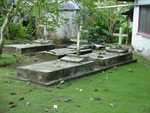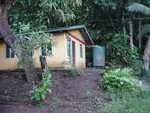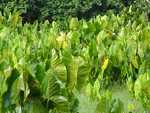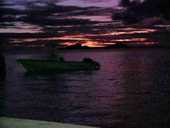| |

Hello everyone! Today was our last full day on Chuuk. We will fly to Honolulu, Hawaii early tomorrow morning where we will visit Pearl Harbor and continue to learn about WWII. Because of the time changes and the International Date Line, we'll actually get to Honolulu before we leave. Talk about weird!
Tonight, Tom and I had planned to have dinner with an outer island family. Unfortunately, we found out this morning that our dinner was cancelled. But never fear! I know from the emails and chats that many of you are curious about traditional Micronesian food and breadfruit, so I managed to scrape up some information and even a few recipes for you. Since we didn't have to get ready for dinner, Tom and I used the afternoon to explore the south end of the island. We will share our observations of the countryside and what we learned about the FSM economy. After our walk, it was time to say goodbye to Chuuk and begin packing our bags.
An Unfortunate Situation
If things had gone as planned, we would have shared dinner with an outer island family tonight whose lifestyle is very traditional, close to how life was here a hundred years ago. On outer islands, families fish and grow breadfruit and other crops for sustenance. The family we planned to dine with is related to Elvis Sharai, who arranged the event for us. Unfortunately, Mr. Sharai's wife has become very ill and the family we were going to visit came to Weno to help care for her.
From this experience, we learned that getting good medical care in Chuuk can be a real challenge. We met several people who said that people from Chuuk sometimes go to Guam for health care. If people get very ill, they often go to Hawaii. Mrs. Sharai will be going to Hawaii as soon as she can.
Breadfruit and Recipes
The breadfruit is a Chuukese staple. Other traditional Micronesian crops include taro, yams, tapioca, and bananas.
Breadfruit is very nutritious. It has as much calcium and carbohydrates as taro and more than the white potato. It also contains more potassium than bananas. One-quarter of a small fruit fills your day's quota of vitamin C. When eaten as a staple, breadfruit adds significant amounts of thiamine (B-1), niacin (B-3), vitamin B-6, folate, and magnesium to your diet, with very little fat.
The trick to a good breadfruit is picking it at the right stage. You should buy "green" fruits when the patterns on the rind are large and even, and a milky sap appears on the surface. As breadfruit ripens, the rind and sap turn brown and the flesh becomes pulpy and sweet. Many people like breadfruit ripened till the flesh runs, then roasted over a fire or steamed in an imu (wood-fired clay oven).
When you cut open a breadfruit, it looks white and is starchy like a potato. In fact, you can prepare breadfruit in many of the same ways as a potato. You can boil it, bake it, steam it, fry it, grate it or mash it. It tastes both hearty and bland, with a fruity aroma. One of the most flavorful ways to eat breadfruit is baked in the oven, like squash. If you want to taste a baked breadfruit, try this recipe. Scrape the skin off the breadfruit with a knife. Then put it in a pan with a little water and roast at 350° to 375° F for an hour or more, until a skewer passes through easily. You can core it and stuff it with rice and vegetables before baking. You can also microwave a breadfruit if you want and use it any way you would use a potato.
For some more complicated breadfruit recipes, try these Micronesian dishes. If you can't find breadfruit, you can substitute taro in the same recipes.
Breadfruit Salad
Ingredients:
- 3 cup cooked breadfruit or taro
- ½ cup cooked beans
- ½ cup sliced cucumber
- 2 tablespoons chopped green onions
- 1 cup cooked fish and/or meat, egg, chicken
- ½ cup sliced tomato
- ½ cup shredded cabbage
- ½ teaspoon salt
- salad dressing to moisten
Directions:
Combine all ingredients, mixing lightly with salad dressing. Serve on lettuce leaf.
Baked Stuffed Breadfruit
Ingredients:
- 1 whole breadfruit
- 1/2 lb. minced meat
- 1 onion chopped
- 1 oz butter
- 1/4 lb. minced ham
- 1 tomato chopped
- 1 clove garlic
- chives
- salt and pepper
Directions:
Parboil breadfruit in salted water. Sauté onion, garlic, and chives in oil. Add meats and lightly fry, adding tomato, salt, and pepper. Peel and core the breadfruit, fill with mixture, brush with butter and bake in greased dish in 350 degree oven for about 30 minutes, basting from time to time. Serve hot.
I'd be curious to know how your breadfruit recipes turn out. If you try these dishes, tell me what you think of them by emailing me at adventure@iamcopernicus.com.
Exploring the Countryside
This afternoon, Tom and I took a long walk through the countryside. As we started on our walk, we saw all sorts of houses and took these photos of them so you could get an idea of what typical village dwellings look like.
(Click on any photo to enlarge it.)
 One curious thing we noticed was that many of the houses had graveyards on their front lawns. The graves were not only above ground, but they frequently were very close to the houses! In one yard, there was a grave only inches from the front porch. Looking at these front-yard graveyards, we started to wonder whether this was a common practice in Chuuk. After investigating a bit (by asking everyone who would answer more of my questions), we found out that this is done all over the islands and is the normal way to bury people.
One curious thing we noticed was that many of the houses had graveyards on their front lawns. The graves were not only above ground, but they frequently were very close to the houses! In one yard, there was a grave only inches from the front porch. Looking at these front-yard graveyards, we started to wonder whether this was a common practice in Chuuk. After investigating a bit (by asking everyone who would answer more of my questions), we found out that this is done all over the islands and is the normal way to bury people.
 As we continued our walk, we observed several houses with rainwater collection systems. These systems consist of rain gutters on the roof that drain into a large cistern (holding tank). Rainwater collection systems allow houses that aren't connected to the treated water supply of the island to get water. Families on the outer islands also collect their own water in this manner.
As we continued our walk, we observed several houses with rainwater collection systems. These systems consist of rain gutters on the roof that drain into a large cistern (holding tank). Rainwater collection systems allow houses that aren't connected to the treated water supply of the island to get water. Families on the outer islands also collect their own water in this manner.
On our walk, Tom and I saw many children out and about, doing chores and playing in their yards. At first I was hesitant to take photos because the children were very shy. Eventually, a few kids got bold enough to come near us and wave hello. They let me take some photos and acted very unimpressed when I showed them their pictures on the digital camera (which shows photos instantly on a small screen). But you should have seen them running off to tell their mother all about it as we left!
FSM Economy
 Seeing the living conditions in the countryside made me start to think about how people on Chuuk make a living. Many people move to Weno from the outer islands of Chuuk looking for work. Minimum wage jobs on Weno pay $1.35 per hour. Even if you don't work in Chuuk, you won't starve (but you won't be well off either). You can collect breadfruit from the trees, along with bananas, papayas, and mangoes. You can raise a few pigs and chickens for meat and you can plant a small garden. One of the common things people plant is taro, a vegetable that tastes similar to a sweet potato. Here is a photo of a taro patch we saw on our walk.
Seeing the living conditions in the countryside made me start to think about how people on Chuuk make a living. Many people move to Weno from the outer islands of Chuuk looking for work. Minimum wage jobs on Weno pay $1.35 per hour. Even if you don't work in Chuuk, you won't starve (but you won't be well off either). You can collect breadfruit from the trees, along with bananas, papayas, and mangoes. You can raise a few pigs and chickens for meat and you can plant a small garden. One of the common things people plant is taro, a vegetable that tastes similar to a sweet potato. Here is a photo of a taro patch we saw on our walk.
In general, the Federated States of Micronesia (FSM) has a very different type of economy than other places I have traveled, mainly because they get such a high percentage of their money from the U.S. in exchange for permission to have Naval bases in the region.
The FSM economy is far from self-sufficient. FSM exports are limited to copra, handicrafts, and few marine products, so it depends on the U.S. for economic aid. To make problems worse, the FSM continues to increase its imports, so that it relies more and more on other countries, primarily the U.S. With little to trade except their water and land (which they have at times traded to the U.S. military, Japanese hotel chains, and tuna fishers), Micronesians are forced to live off U.S. aid.
The state of Chuuk gets about $43 million of U.S. aid annually. Some people criticize Chuuk officials for not spending this money wisely and sometimes Chuuk is not able to pay its bills. As a result of low funding, the school year in Chuuk public schools has been cut short.
In other journals, we have explained how the FSM was colonized by other nations in the past. This history is a big part of the reason that the FSM is unable to sustain itself. Because it was a possession of one country or another from 1864 to 1986, the islands never had the chance to practice and develop self-sufficiency. To reach economic independence, the FSM will have to play a good deal of catch-up in the years to come.
Goodbye to Chuuk
 Tom and I are sad to be leaving Chuuk. In many ways we only scratched the surface of this fascinating place during our short visit. It would take years to really get to know the culture and the people of the "tiny islands" that make up Micronesia. We could also spend months and months exploring the dozens of wrecks in the lagoon. I can't believe the things we saw underwater, like the amazing marine life and coral, as well as artifacts from the war. Tom and I plan to return someday to continue our exploration.
Tom and I are sad to be leaving Chuuk. In many ways we only scratched the surface of this fascinating place during our short visit. It would take years to really get to know the culture and the people of the "tiny islands" that make up Micronesia. We could also spend months and months exploring the dozens of wrecks in the lagoon. I can't believe the things we saw underwater, like the amazing marine life and coral, as well as artifacts from the war. Tom and I plan to return someday to continue our exploration.
I want to end my journal today with the preamble to the Constitution of the Federated States of Micronesia. It conveys quite beautifully a sense of the culture and beliefs of these islands. It also expresses the Micronesian people's dream of the future.
"With this Constitution, we affirm our common wish to live together in peace and harmony, to preserve the heritage of the past and to protect the promise of the future.
To make one nation of many islands, we respect the diversity of our cultures. Our differences enrich us. The seas bring us together, they do not separate us. Our islands sustain us, our island nation enlarges us and makes us stronger.
Our ancestors, who made their homes on these islands, displaced no other people. We, who remain, wish no other home than this. Having known war, we hope for peace. Having been divided, we wish unity. Having been ruled, we seek freedom.
…We extend to all nations what we seek from each: peace, friendship, cooperation and love in our common humanity."
Karen
|


